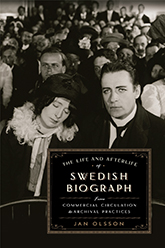|
The Life and Afterlife of Swedish Biograph
From Commercial Circulation to Archival Practices
Jan Olsson
“Fusing together archival digging, business history, film politics, and film and cultural analysis, Jan Olsson offers a rich exploration of how Sweden’s Golden Age of silent cinema came to be. Anyone with an interest in film history will want to read The Life and Afterlife of Swedish Biograph, the first full-length work of English-language scholarship to tackle the subject.”
—Andrew Nestingen, author of The Cinema of Aki Kaurismäki: Contrarian Stories
A fresh and nuanced look at a canonical film studio
Sweden’s early film industry was dominated by Swedish Biograph (Svenska Biografteatern), home to star directors like Victor Sjöström and Mauritz Stiller. It is nostalgically remembered as the generative site of a nascent national artform, encapsulating a quintessentially Nordic aesthetic—the epicenter of Sweden’s cinematic Golden Age. In The Life and Afterlife of Swedish Biograph, veteran film scholar Jan Olsson takes a hard look at this established, romanticized narrative and offers a far more complete, complex, and nuanced story.
Nearly all of the studio’s original negatives were destroyed in an explosion in 1941, but Olsson’s comprehensive archival research shows how the company operated in a commercial, international arena, and how it was influenced not just by Nordic aesthetics or individual genius but also by foreign audiences’ expectations, technological demands, Hollywood innovations, and the gritty back-and-forth between economic pressures, government interference, and artistic desires. Olsson’s focus is wide, encompassing the studio’s production practices, business affairs, and cinematographic conventions, as well as the latter-day archival efforts that both preserved and obscured parts of Swedish Biograph’s story, helping construct the company’s rosy legacy. The result is a necessary rewrite to Swedish film historiography and a far fuller picture of a canonical film studio.
 Jan Olsson is professor emeritus of cinema studies at Stockholm University. The author of Hitchcock à la Carte and the founding editor of Aura: Film Studies Journal, he has published widely on multiple aspects of film and media studies.
Jan Olsson is professor emeritus of cinema studies at Stockholm University. The author of Hitchcock à la Carte and the founding editor of Aura: Film Studies Journal, he has published widely on multiple aspects of film and media studies.
Praise
“Recovers and explores a canonical period of silent-era Swedish film history that has previously been woefully neglected. Jan Olsson does a magisterial job of contextualizing and triangulating lost materials and treasures through deep research and analysis. An invaluable contribution.”
—Arne Lunde, author of Nordic Exposures: Scandinavian Identities in Classical Hollywood Cinema
“Using scattered and elusive archival material creatively and astutely, Jan Olsson delivers a comprehensive and contextualised history that provides new, exciting, and all-embracing perspectives of the company that made Swedish cinema world-famous. This is an indispensable contribution to this critical period in Swedish film history.”
—Ann-Kristin Wallengren, Lund University
“Offers a rich exploration of both business and economics, film production practices, changes in film style, and commercial misgivings, to quote some of the chapter headings. The book is written with exquisite prose and is a pure pleasure to read.”
—Nordicom Review
“Olsson is the perfect man for the job of illuminating the many lives of the films produced by Svenska Bio in the early 1910s, and putting early Swedish cinema back on the map of early film history internationally. . . . The Life and Afterlife of Swedish Biograph is rich and rewarding.”
—Scandinavian Studies
Table of Contents
Contents
List of Illustrations
Acknowledgments
Concepts and Considerations: An Introduction 3
1 Business and Economics
2 Starting Up the Lidingö Studio
3 Novel Production Practices: 1913
4 Productions and Alliances: 1914–1916
5 Conceptual Indicators of Changes in Film Style
6 From “Nonsense to Film Art: Historiographic Negotiations
7 Critical Recognition and Commercial Misgivings: Responses from Key Markets
8 Crossroads: From Lidingö to Berlin via Dalecarlia and London
9 Archival Practices: From the Swedish Film Society and First-Generation Scholarship to the Swedish Film Institute
Conclusion
Appendix 1. Intertitles and Other Indications of Temporal Shifts Between Reels in Films from 1912 to 1916
Appendix 2. Svensk Filmindustri’s Educational Department Catalogs
Appendix 3. Directors at the SB Studio (Apart from Sjöström and Stiller)
Notes 000
Selected Bibliography
Index
|

Larger images
December 2022
LC: 2022007626 PN
312 pp. 6 x 9
30 b/w illus.
|

